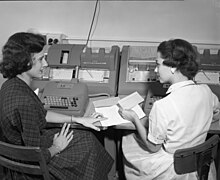
Two-pass verification, also called double data entry, is a data entry quality control method that was originally employed when data records were entered onto sequential 80-column Hollerith cards with a keypunch. In the first pass through a set of records, the data keystrokes were entered onto each card as the data entry operator typed them. On the second pass through the batch, an operator at a separate machine, called a verifier, entered the same data. The verifier compared the second operator's keystrokes with the contents of the original card. If there were no differences, a verification notch was punched on the right edge of the card.[1]
The IBM 056 and 059 Card Verifiers were companion machines to the IBM 026 and 029 keypunches, respectively. The later IBM 129 keypunch also could operate as a verifier. In that mode, it read a completed card (record) and loaded the 80 keystrokes into a buffer. A data entry operator reentered the record and the keypunch compared the new keystrokes with those loaded into the buffer. If a discrepancy occurred the operator was given a chance to reenter that keystroke and ultimately overwrite the entry in the buffer. If all keystrokes matched the original card, it was passed through and received a verification punch. If corrections were required, then the operator was prompted to discard the original card and insert a fresh card on which corrected keystrokes were typed. The corrected record (card) was passed through and received a corrected verification punch.[2]
- ^ "Everything about punch cards". December 28, 2012. Retrieved June 20, 2013.
- ^ "IBM 129 Data Card Recorder" (PDF). Retrieved 2024-02-08.